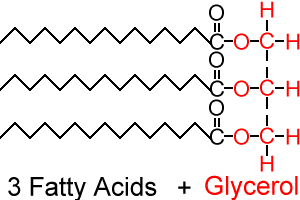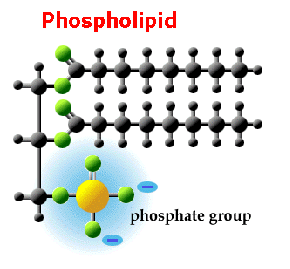? Lipids (FREE SAMPLE)
The A Level Biologist - Your Hub February 12, 2020
Membranes are made of phospholipids , which are made of lipids . Lipids are the stuff of oils, fats and waxes. Unlike proteins and carbohydrates, lipids are not polymers. Lipids which store energy are triglycerides , while those which form membranes are phospholipids. Triglycerides are formed by a molecule of glycerol with three fatty acids attached. The reaction which results in triglycerides is condensation .
Glycerol (green) + 3x fatty acids (red) The fatty acids can be simplified in drawing:

The bonds formed (C-O) are called ester bonds . Fatty acids can be saturated or unsaturated (monounsaturated; polyunsaturated). Saturated fatty acids have all their carbon (C) atoms linked to hydrogen (H) atoms, hence saturated with hydrogen . If there is a carbon atom with a double bond to its neighbour carbon atom, then it will only have one bond to a hydrogen atom, hence it is unsaturated. If there is one double bond present, the fatty acid is monounsaturated . If there are multiple double bonds present, the fatty acid is polyunsaturated . In phospholipids one of the fatty acids is replaced by a phosphate group .

The test for lipids is the emulsion test . This test takes advantage of the property of lipids of not dissolving in water, but dissolving in ethanol (alcohol). You dissolve the sample into ethanol by shaking, then pour it into water. If milky white droplets are formed, the sample is positive for lipids.
